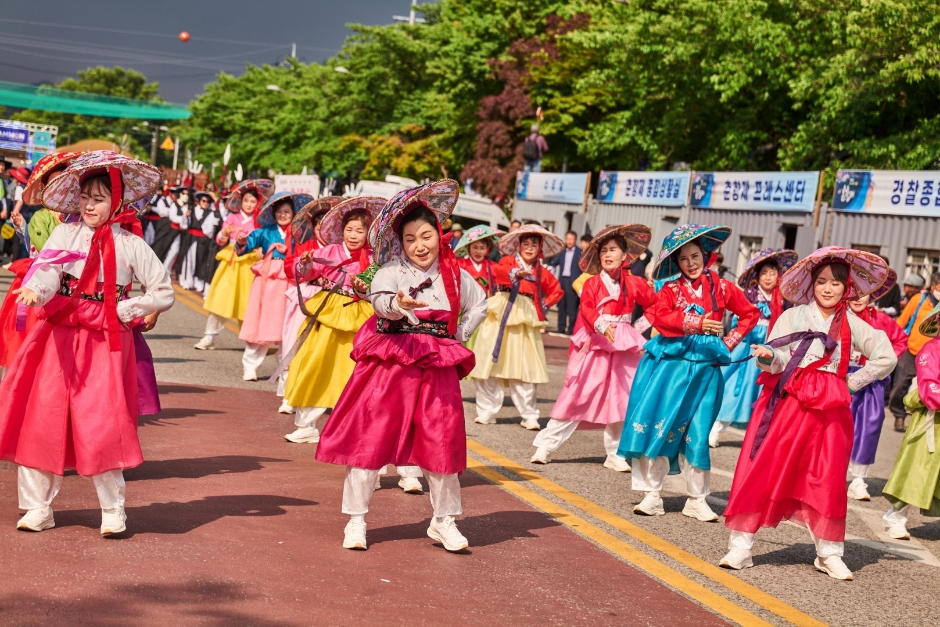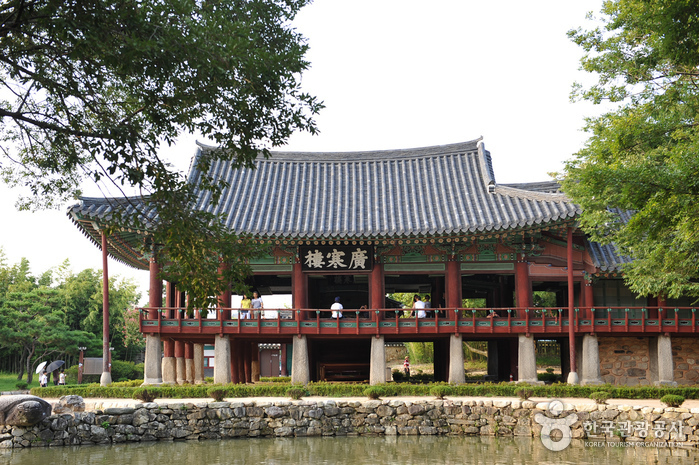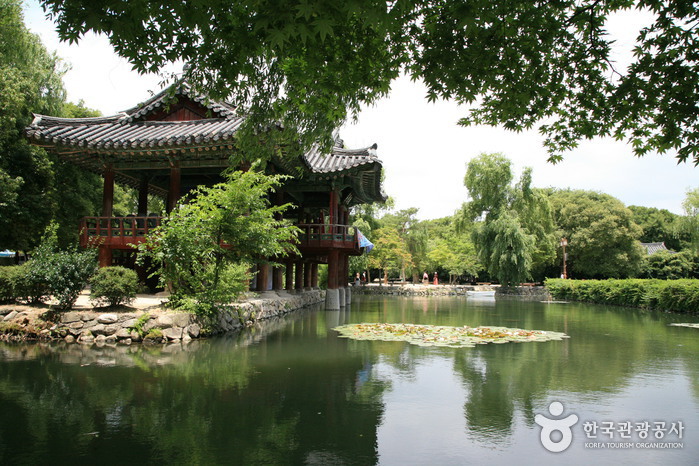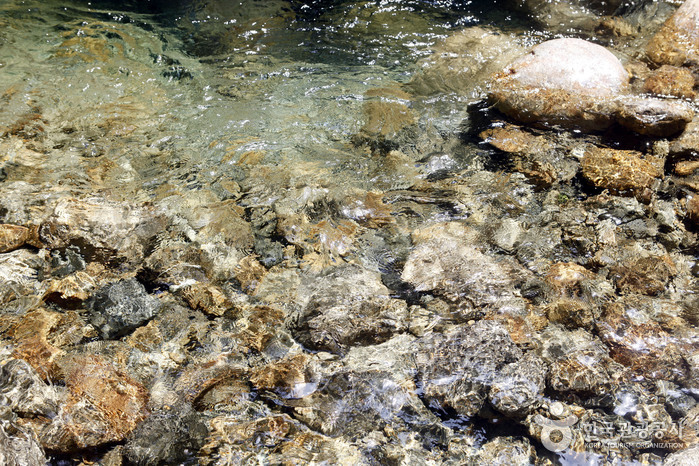Nogodan Guesthose (노고단 게스트하우스&호텔)
15.3Km 1001 2024-08-01
40 , Hagwan 1-gil, Gurye-gun, Jeollanam-do
+82-61-782-1507
Nogodan Guesthouse & Hotel is located in Gwansan-ri, Gurye-gun, Jeollanam-do, and is popular with weekend trippers and family vacationers visiting Jirisan National Park. Local hot spring water (high in traces of germanium) is provided in all rooms, so residents can relieve their fatigue in a hot spring bath after hiking; while from the hotel’s rooftop garden residents can enjoy fine views of Jirisan Mountain. A shuttle service to Nogodan, where the Jirisan trail starts, costs 20,000 won per person for the round trip. And at the 1st floor Buen Camino Restaurant & Pub l you can enjoy Jirisan black pork barbecue, Jirisan zucchini pancake, and seasonal vegetable side dishes.
Namwonyechon by Kensington [Korea Quality] / 남원예촌 [한국관광 품질인증]
15.3Km 1191 2024-04-07
17 , Gwanghanbuk-ro, Namwon-si, Jeonbuk-do
+82-63-636-8001
Namwonyechon in Namwon, Jeollabuk-do, combines the beauty of traditional hanok with the convenience of a hotel. In summer, rooms with daecheongmaru are popular, and in winter, you can cozy up to an oakwood fire. A hanbok experience, pansori and gayageum performances, and a traditional games experience are provided free of charge. Residents get a free entry pass with mapae(a certificate to allow officials to use horses) to nearby Gwanghalluwon Garden, Chunhyang Theme Park, and Baekdudaegan Ecological Education Center. Room minibars are also free of charge.
Chunhyang Festival (춘향제)
15.4Km 23174 2024-04-07
1447 Yocheon-ro, Namwon-si, Jeonbuk-do
+82-63-620-5770
Taking place in Namwon, Chunhyang Festival celebrates the love between Chunhyang and Lee Mongryong, based on the famous Korean love story, Chunhyangjeon. Held since 1931, the festival aims to spread the story not only around Korea but to international visitors as well through hands-on experiences and moving performances. The highlight of the festival is the beauty pageant that attracts many people.
Stayriun [Korea Quality]스테이리운[한국관광 품질인증]
15.4Km 0 2024-08-14
53-7 , Gosaem-gil, Namwon-si, Jeonbuk-do
+82-507-1493-0660
Stayriun is a private hanok adjacent to the famous Gwanghalluwon Garden in Namwon, Jeollabuk-do. Accommodation is in the sarangchae and the main building. The sarangchae is a cozy space for two people with a small yard and a wooden maru where you can enjoy a cup of tea. The main building has high ceilings, large windows and a terrace, giving a sense of openness; the floor is neatly finished in wood and stone. There’s a beam projector, and an indoor spa.
Gwanghallu Pavilion (광한루)
15.4Km 17523 2024-04-07
1447, Yocheon-ro, Namwon-si, Jeonbuk-do
+82-63-620-6172
Rebuilt in 1638 (the 16th year of King Injo), Gwanghallu Pavilion is one of the Joseon dynasty’s most exemplary structures. The pavilion was constructed in 1419 by Hwang Hui, a noted prime minister in the early Joseon dynasty, during his exile to Namwon. The name of the pavilion at that time was Gwangtongnu. In 1434, while the pavilion was undergoing reconstruction, scholar and politician Jeong In-ji called it Gwanghallu after Gwanghancheongheobu, the mythical palace on the moon. Designated as Treasure No. 281, the pavilion is one of four major pavilions known for excellent craftsmanship, along with Yeongnamnu Pavilion (Miryang), Chokseongnu Pavilion (Jinju), and Bubyeoknu (Pyeongyang). Gwanghalluwon Garden, which consists of Gwanghallu Pavilion, a pond, Bangjangjeon Pavilion, and Yeongjugak Pavilion form Historic Site No. 33.
Gwanghalluwon Garden (광한루원)
15.4Km 25195 2024-04-07
1447, Yocheon-ro, Namwon-si, Jeonbuk-do
+82-63-625-4861
Originally known as Gwangtongnu, Gwanghalluwon Garden was built by Hwang Hui Jeongseung in 1419 during the reign of Joseon dynasty’s King Sejong. Because of its outstanding beauty, Governor Jeong In-ji gave the garden the name ‘Gwanghallu’ in 1444, comparing it to a garden from the palace on the moon. It is famous as the location where Lee Mong-ryong and Chunhyang (two lovers from a well-known Korean folk story) first met. In the 1920s Chunhyangsa Temple was established in the neighboring area and a portrait of Chunhyang was hung in a place of honor. The garden is the venue of the Chunhyangjae Festival every spring, celebrating the deep and lasting love of the famous couple. The area around Gwanghalluwon Garden is full of many attractions, includes Ojakgyo Bridge, symbolizing the bridge connecting Chilseok and Gyeonwu from the traditional story of Chilseok, as well as Chunhyang Hall, Wolmae-jip (house of Chunhyang's mother), Wanwoljeong Pavilion, Yeongjugak Pavilion, Samsinsan and many other traditional buildings.
The Face Shop [Tax Refund Shop] (더페이스샵)
15.7Km 0 2024-04-22
385-16, Nammun-ro, Namwon-si, Jeollabuk-do
-
Banghwadong Recreational Forest (방화동 자연휴양림,가족휴가촌)
17.3Km 6039 2024-04-07
778, Banghwadong-ro, Jangsu-gun, Jeonbuk-do
+82-63-350-2474
Banghwadong Recreational Forest is located at the foot of Jangansan Mountain. The mountain trail from Deoksanyongso Pond leading to Banghwadonggyegok Valley features nature learning centers and adventure games facilities. The clean valley is lined with oddly shaped cliffs, shrubs and trees, which all combine into a splendid view. The forest is situated at a highland more than 500 meters above sea level. It is surrounded by mountains that are over a thousand meters above sea level, so the temperature is low and the water at the valley is cool even in the summer.
There are log cabins, group accommodation facilities, and training halls by the valley to accommodate group visits, conferences, gatherings and seminars. The recreational forest also operates Banghwadong Family Vacation Village for family visitors, equipped with accommodation facilities, various camping sites, and a wood carving experience center.
Jirisan Chilseongyegok Valley (칠선계곡(지리산))
17.4Km 34739 2022-07-29
Chuseong-ri, Hamnyang-gun, Gyeongsangnam-do
+82-55-970-1000
Chilseongyegok Valley is the most beautiful valley in Jirisan Mountain, and is one of the top three valleys in the nation, along with Cheonbuldonggyegok Valley in Seoraksan Mountain and Tamnagyegok Valley in Hallasan Mountain. The 16-kilometer valley stretching from Uitan of Macheon-myeon to Cheonwangbong Peak is characterized by very tough topography but beautiful scenery and is the only remaining primeval forest of Jirisan Mountain. It is also dotted with seven waterfalls and 33 ponds. The hike becomes more difficult as the trail enters the valley. Because the valley has taken many lives, some people call it "The Valley of Death." For that reason, visitors must apply in advance and hike with a guide. The trail in Chilseon Valley is a 9.4-kilometer course from Chuseong Village in Macheon-myeon to Cheonwangbong Peak, which does not follow the natural valley, due to the valley's steep and dangerous features. Starting from Chuseong Village, the trail passes Yongso Pond, Jujiteo Site, Chuseongmang Rock, Seonnyeotang Pond, Ongnyeotang Pond, Biseondam, Chilseonpokpo Falls, Daeryukpokpo Falls, Samcheungpokpo Falls and Mapokpo Falls, all before reaching Cheonwangbong Peak.
![Namwonyechon by Kensington [Korea Quality] / 남원예촌 [한국관광 품질인증]](http://tong.visitkorea.or.kr/cms/resource/25/2556425_image2_1.jpg)



![The Face Shop [Tax Refund Shop] (더페이스샵)](http://tong.visitkorea.or.kr/cms/resource/77/2890977_image2_1.jpg)


 English
English
 한국어
한국어 日本語
日本語 中文(简体)
中文(简体) Deutsch
Deutsch Français
Français Español
Español Русский
Русский